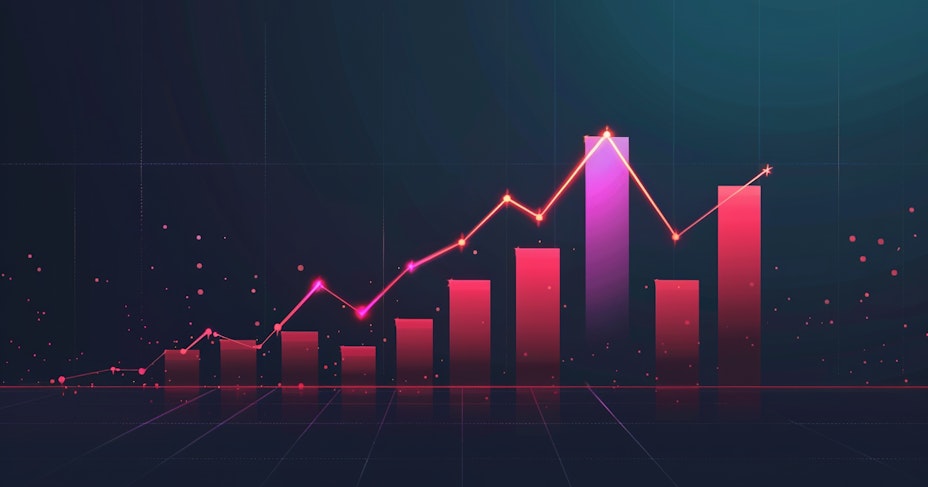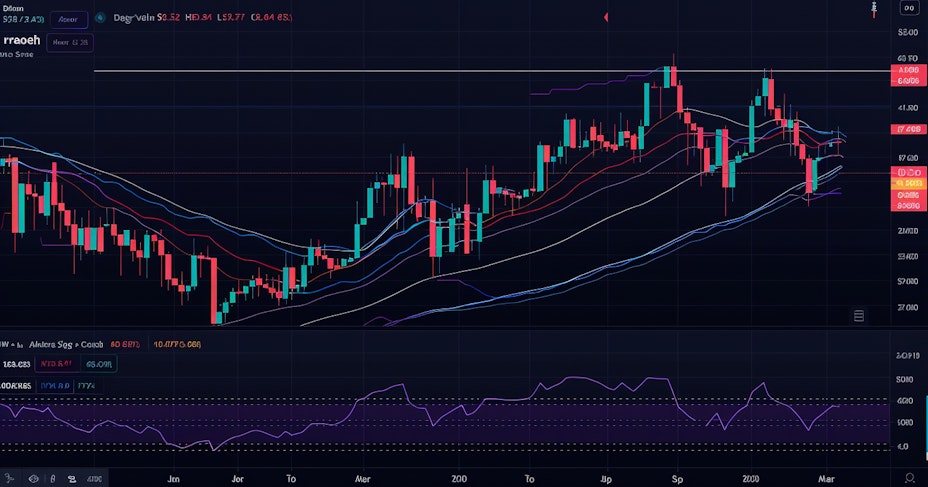Trends and hypes in crypto
- 15 minute read

A trend is an important clue in trading. A hype is a sudden rise of a crypto and attracts bettors. Trends can be seen in technical analysis, hypes come out of the blue.
A trend in crypto means the price of a coin going in the same direction for an extended period of time. A hype in crypto is a temporary popularity of a type of cryptocurrency. Trends and hypes in crypto are important parts of crypto trading.

- A trend describes the direction in which the price of a crypto has been going for a while, such as a rising or falling trend
- A trend is often observed using technical analysis, support and resistance
- Trends are only significant for certain periods, day traders have nothing to gain from daily candlesticks
- Moving Averages sometimes show a golden cross or a death cross in the chart of Bitcoin, which is seen by a lot of traders as the most important entry or exit point when trading crypto
- When using technical analysis, it is a good idea to account for delays in signals that you can see coming from afar, such as the slow approach of a golden or death cross
- Frequently used indicators from technical analysis have a highly predictable effect because they are so widely used, a kind of herding behavior
- Candlestick trend patterns also have predictable value because certain patterns look so recognizable that people take action on them, such as the head and shoulders pattern
- Self fulfilling prophecy is a common way in which patterns create action by traders, as trend followers combine to create higher volumes and more violent price movements
- There are also recurring trends, such as the rise of meme coins or penny coins in a bull market
- A hype in crypto occurs when very large groups of traders suddenly start buying the same coin(s)
- Most hypes are like fashion; they come and go
- Occasionally, a hype manages to produce an established category, such as the DeFi hype
- Hypes are accompanied by a lot of media attention and a lot of people who are quick to take advantage of them, such as influencers or celebrities who start advocating all sorts of things
- When following social media, it is smart to never forget the self-interests of the people posting it
- When in doubt about a hype, do some reading about past hypes and see what the prices have done of the coins that belonged to these hypes, that way you avoid excessive risks and prediction
- Those who want to sleep peacefully do follow the trends, but avoid the hypes
Content
- What is a trend in crypto?
- Trends and technical analysis
- Trend patterns
- Trends in crypto outside of technical analysis
- What is a hype in crypto?
- The importance of your own research
- Conclusion
What is a trend in crypto?
A trend in crypto is a term from technical analysis. There are several forms of trends, but we will cover the most familiar and common.
Prices of cryptocurrencies go up and down. When the price of a coin has been going up for a while, we can say that the trend is upward. Followed by this the so called support and resistance can be indicated.

In the above chart you can see that the trend of the price-line is upward. The resistance is the highest point in this chart and the support is the purple highlighted point with the lowest volume bar.
Trends and technical analysis
Many people use technical analysis to keep an eye on these three numbers so they plan a good entry point and when they can sell their coins again at a good time. The trend is your friend, they say.
Support and resistance
Let's say the support in this chart is located at 3€ and the resistance is at 7€. A logical course of action would then be to buy around 3€ and sell around 7€.
If the support and resistance are known, traders in the above example will start buying again around 3, increasing predictability. After all, if people start buying again, the price will necessarily go up again. The same goes of course for the resistance, if the price gets close to this high many traders will start selling, causing the price to drop.
Outbreaks
What traders also watch for are trend breaks. This can be either upward or downward. In the case above, a trend break would occur if the price falls below 3 or goes above 7.
If it rises above 7, many traders work with a new support and resistance. Thus the former resistance is often taken as the new support. The same principle applies to the bottom. The former support now becomes the resistance. In case of an upward or downward breakout, it is wise to test the new support and resistance first and see if these levels are maintained. After a trend break, prices can be a lot more volatile due to turmoil in the crypto market.
The purpose of watching trends is to predict what the market participants will do using technical analysis. Thus, the purpose of understanding crypto trends is to predict entry or exit points.
Trends by period

Trends also come in all shapes and sizes. A day trader is looking for very different trend signals than a swing trader. As a day trader you want to make small profits once or more a day. So you are looking for a trend that lasts for minutes to determine the direction of the candles. If you get confirmation (a few green or red candles in a row during a certain period) you could interpret this as a buy or sell signal.
Basically the same thing what the swing trader does, with the only difference being the duration of the trade. In swing trading you are talking about days to weeks. You buy around the support line and sell around the resistance line.
Some traders work with a much longer time horizon. These could be called investors and they work with plans that span months to years. The trend lines they use may represent, for example, the 50 and 200 day Moving Average (MA). When those two lines cross, it could be interpreted as a strong buy or sell signal.
Moving Averages
A Moving Average sums up all prices over the past time and displays the average. In the case of a 50 day MA, all average daily prices are summed and divided by 50. Basically calculating the arithmetic mean. In the case of a 50 and 200 day MA, all prices over the past 50 days are summed and divided by 50 and displayed in a chart. The same technique is used for the 200 day MA. These lines rarely cross each other and therefore are strong signals that the market is moving in a different direction, for example from a buyers' market to a sellers' market, or from a bear market to a bull market.
The general maxim here is that the longer the timeframe is, the more reliable the trend and signal is.
Golden cross and death cross
You may have heard the technical terms for this before, namely golden cross and death cross. In a golden cross the 50-day MA goes up through the 200-day MA (some traders use other timeframes, such as 50 and 100) in a chart like the one shown above. You must then have a chart in view where the 50-day and 200-day MA are indicated as indicators.
This is usually taken as a very strong bullish signal for long-term investors and this has worked many times in the past. Otherwise this strong terminology would not have been used for it. There is then a long-term trend (decline in prices) that is broken by a new rising trend that is significant. It is so significant because not only has the trend been broken, but also because anyone doing technical analysis recognizes the golden cross and starts to take action accordingly, which can accelerate things.
Thus, if such an investor discovers a golden cross on Bitcoin's chart (the benchmark in crypto and leader of market trends) he will take certain actions that he has predetermined, for example, diverse portfolio purchases consisting of all kinds of different coins. If you are going to invest, you can also keep an eye out for a golden cross in the Bitcoin chart by using TradingView and adding the 50- and 200-day MA, for example. You could then invest at a golden cross and sell again at a death cross.
A death cross is the opposite of a golden cross. In this, the 50-day moving average (MA) goes down through the 200-day MA. This is a very strong bearish signal, indicating that the market participants have sold more than they bought in the last 50 days compared to the respective 200-day period. This pattern is seen by most traders as an indication that the market might continue to fall for a longer time. So by working with these long-term trend signals, you could indicate the beginning of a bear market and the end of a bull market . This is very important for timing your entries and following your crypto exit strategy .
Limitations of technical analysis
With all these signals from technical analysis, however, a few points should be noted. No market behaves as it should according to indicators from technical analysis. Especially the crypto market is characterized by much higher volatility and black swans, such as flash crashes or excessive advances without any prior signals.
Delay signals prolonged patterns
A day late and a dollar short . When you are working with such long time frames of 50 and 200 days there may very well be a considerable lag on a signal. Perhaps this is a good indicator to determine whether the bull market has ended or one is entering, but if you sell that late you may already have lost quite a bit of your profits or only buy in when prices have already risen significantly. In 2018, for example, you saw a death cross appear in March, when prices had already crashed very hard. Therefore, using long-term indicators is limited and you will also have to work with indicators with a much shorter time horizon to be able to trade in the moment as well.
Still, it's not a bad idea to look at it if you have doubts about whether the bull market has started or ended. It remains a strong signal, especially for newcomers who don't know Bitcoin's 4-year market cycle very well yet. Nobody wants to keep their coins if the prices keep falling, they can lose as much as 90-95% of their value during a bear market. Nobody wants to buy coins too high either. If you see that the 50-day MA is moving toward the 200-day MA, whether it is up or down, you may already be able to pre-emptively sell part of your stack or buy back cautiously.
Commonly used indicators

Popular technical analysis indicators have a high bandwagon and self-fulfilling prophecy content: because many people work with them, they make people buy and sell when the indicator says you should. If the indicator says you should sell at this Fibonacci level, so many people do, that it is more often than not correct.
Therefore, it doesn't hurt to know the most commonly used indicators and take a look at them. Perhaps you can use a few of them in your crypto adventure and jump on the bandwagon as well. Some may seem more logical to you than others. You can just use the indicators that you understand, so you will also be looking at indicators that millions of other traders are also looking at.
The most commonly used indicators are:
- Moving Averages (multiple types), these add up the prices of, say, past 50 days and divide by 50 to arrive at an arithmetic mean.
- Relative Strength Index (RSI) , simple to understand indicator that reflects whether a crypto is oversold or overbought or in between. Below 30 is oversold and a buy indicator. Above 70 the underlying is overbought is a sell signal and in between you do nothing as a trader.
- Bollinger Bands , these use a Moving Average (usually 20) and create a bandwidth around it. The higher the volatility, the wider the bands become. If the price breaks outside then band this is a buy or sell signal.
- Fibonacci Retracements , a Fibonacci sequence is a number sequence that explains the development of natural elements and is also said to occur in the development of stock and cryptocurrency prices. A Fibonacci sequence consists of numbers that always add the previous two numbers: 0, 1, 1, 2, 3, 5, 8, 13, 21, 34, 55, 89, 144, et cetera. A ratio is calculated by dividing a number by a higher number in the sequence. For example, a well-known ratio is 34/55 = 0.618. Fibonacci saw that a person's navel was 61.8% of its total size from the ground. It's a bit like numerology for traders, but well, many people work with it.
- Volume indicators, these show how much of a cryptocurrency is bought and sold in a day and whether there is a surplus on either side. Higher volumes mean more significant developments.
There are more to name, but the more people use an indicator, the more powerful its predictive power becomes. If people get a signal from a popular indicator, many people will take advantage of it and buy or sell. As a result, the signal becomes a self-fulfilling prophecy. Just try it out and see if it is correct. Also remember that signals with high volumes are more powerful than with lower ones.
Trend patterns
In addition to trend indicators, there are also well-known candlestick trend patterns. Most commonly used are the daily candlesticks, which form trend patterns that have a recognizable appearance. The best known is the head and shoulders. Everybody knows what a head and shoulders looks like.
Head and shoulders bearish pattern
This pattern has proven its worth many times in the past. If you see something like this appear over a longer period of a cryptocurrency then this is a bearish pattern. For a while the price goes up, then it drops back a bit to the support, then it makes an even higher price and then drops back to the support again and finally it taps the high of the first rise only to break firmly through the support and lose a lot of value. This can be seen in Bitcoin's chart during the last bull market 2021-2022, after which the bear market began.
The inverted head and shoulders is a bullish pattern.
Known trend patterns crypto
For example, there are some trend patterns that are so well known that traders actually take them into account, namely:
- Double top or double bottom
- Flags
- Triangles
- Wedges
It's going too far to go into it completely in this blog article, but because these patterns are so well known you again get into the self fulfilling prophecy. The more people notice the pattern and use it in their trading, the more powerful the pattern works. All of these patterns send bullish or bearish signals.
Trends in crypto outside of technical analysis
There are also trends in crypto that have nothing to do with statistics or charts. For example, there has been a trend in the formation of all kinds of ETFs for a while now. Bitcoin already has several of these and Ethereum is coming as well. The prediction is that this trend will continue and there will also be an ETF for other established coins such as XRP, Cardano and Solana.
Regulation crypto
Regulation of crypto has also been on the rise for a while and has been with the MiCA law laid a solid foundation in the EU, with the protection of users and traders in crypto becoming more and more well regulated, so scams will occur less and less, if all goes well. With the advent of CBDC to blockchain technology, the government and politicians will not only have a finger in the pie in cryptoland, but also in the world of blockchains .
Recurring trends

Recurring trends can also be observed in crypto. For example, we see that meme coins do much better during bull markets than in intermediate periods. These trending crypto coins tend to rise harder than other coins. Even coins that cost little per unit tend to rise faster in bull markets. This is because the market caps of these coins are relatively low, and thus relative changes happen even with low volume.
Example: "Memecoin A", with Market Cap of $1 Million will go up 100% if people invest $1 Million, whereas "Seriouscoin B" with a market cap of $100 Million will go up by only 1% if the same $1 Million is added to the market cap.
Additionally it might be that newbies like to have a lot of coins and still have too little experience to see that the amount of coins doesn't matter. Still, it has a strong influence on the price trend and they are often the best trending crypto coins in terms of profitability.
What is a hype in crypto?
A hype in crypto is an excessive interest in a particular cryptocurrency or category of crypto-currencies, making these cryptocurrencies seem more important than they really are. Usually these hypes also subside, after which such coins can lose value again very quickly. A hype has many similarities to fashion.
With hype, you often see that there is considerable media coverage of specific coins and speculators run with this story and try to grab hefty profits quickly.
There is also more often talk about trending cryptocurrency, but this means something different. Trending crypto-currencies are crypto-currencies that become popular in between, while hype coins usually suddenly quote much higher prices out of nowhere. Examples include coins like MAGA (Trump), Jeo Boden and Kamala Horris, which were suddenly hyped in the run-up to the U.S. election and have been bouncing in all directions ever since.
Hypes becoming mainstream
Occasionally, it may happen that although a hype around a particular theme dies down, the category establishes itself in the perennial CoinGecko charts. A good example of this is the DeFi hype (and now AI), with almost all crypto currencies in this category skyrocketing, after which a number of platforms that had it right nestled into the top 100, such as Maker or AAVE.
Hypes of the past
Anyone who has been around the world of crypto for a while has seen them pass by 1 by 1. Hypes like the ICO , ERC-20 tokens on the Ethereum blockchain, smart contracts platforms, DeFi, metaverse , play to earn , NFT, meme coins and AI . The hypes are flying around your ears. Some hype lasts a little longer than others, but they all eventually pass. Very occasionally a hype moves into an established category, as Meta is trying to achieve with the metaverse.
How does a hype in crypto start?

Hypes are strongly driven by public sentiment. At some point, traders see that certain types of crypto currencies doing better than others. A few buy as many of these coins as possible and some of this kind begin to rise in the rankings. Once the general public sees that a particular theme is popular they begin to buy the highest ranked of that variety en masse, further catching the hype.
Hypes are also often driven by influencers and stories on all kinds of platforms. Influencers have a habit of buying a coin that is popular and then making lots of positive YouTube videos about it so that their followers will also buy this coin. Once they have their usual margin in, they sell this coin again and buy another coin to start the game over again.
Facebook pages, Telegram groups and news sites on CoinGecko, for example, also tend to pay excessive attention to coins that happen to be popular. They make up all kinds of stories about why these are such good coins and that there is a lot to get, but the main goal is actually to attract a lot of readers, a kind of click-bait stories.
Understand what interests are at stake
That's why it's so important to do your own research. Most stories on the Internet are not at all designed to make you a better trader or point you to good opportunities. Almost all of them have their own agenda, except Anycoin Direct of course 😉! Remember that nobody knows which way a market is going.
"Follow the trend lines, not the headlines."
One of the trickiest facets of investing in a hype coin is that you never know when the hype will die down and the coin will take off with a train heading for the basement. If such a coin has a brief dip, you just don't know what to do unless you have determined in advance what risk you are willing to take and at what prices you sell.
The role of social media in hypes
There are also many communities these days that try to drive up the price of a coin by buying together and making a lot of fuss on social media. When creating a meme coin, even the creator can still participate by telling all kinds of stories on the coin's website and on X to inspire his followers to further boost the price.
Thus, on platforms like Solana and Base blockchain, we see all kinds of trending channels emerging where people try to create the new meme coin or hype coin and, of course, make a lot of money together. Some of these are quite successful and that's why you see one meme coin after another (especially) making its appearance. With the advent of the popular presale tokens, these trending coins also already have enough liquidity in the project to have a chance to break through and become the best trending crypto coin.
The importance of your own research

If you zoom out and look at developments of the market over time and look at trends and hypes you will see that many of them are temporary and some stop very abruptly. If you have done that research you will also see the risks of following trends and hypes.
Following a trend is actually quite normal. In technical analysis, it's exactly what you do. You want to recognize crypto trends and make the best use of them using patterns and indicators. If the trend reverses you sell using the same method.
Hypes of the past give clues about hypes of the present
If you pay attention to coins that were part of a hype, you often see that past prices jump in all directions. You run big risks with no clues as to whether it is a good investment or just a temporary popularity. Even if you have done a fundamental analysis and also a technical analysis you can be in for all kinds of surprises.
So if you jump on any hype, it's a good idea to make good arrangements with yourself at what prices you buy and sell again, including if things don't go the right way unexpectedly. This way you protect yourself from excessive prediction and you don't have to face strong declines while you still have the crypto token in your portfolio.
Conclusion
Trends in the crypto world are fairly easy to follow price movements and can steer your crypto adventures in the right direction if you use indicators and patterns correctly.
By zooming out and observing the market cycle, you will also discover longer-term trends. Certain categories simply have a higher utility value.
Hypes in crypto can make you a lot of money, but they can also cost you. That is why it is important to do good research and be very careful about it. You might even choose not to go along with any of the hype. Sleeping easy also has its charms.


